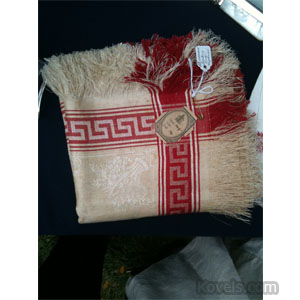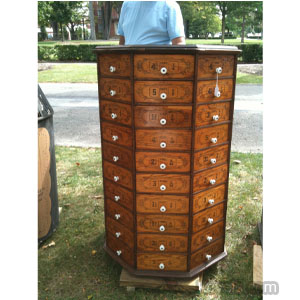The sun was shining, so I went to the annual outdoor antique show in Hudson, Ohio. It’s a fundraiser for a private school, and in the past the show has featured oriental rugs, country furniture, and accessories we might class as “early American.” Last year, dealers sold very little. This year, the economy may still be poor, but customers told me they had decided it was time for a little fun—that buying at a show is enjoyable and their purchases might be good investments.
We asked some dealers what was selling. They mentioned clocks, Ohio pottery, ABC plates, flow blue, brass, wood, pewter and even dominoes. A dealer who specializes in textiles told us she was selling a lot of embroidered dish towels and monogrammed hankies, but not as many “Turkey red” linens as she used to. Few “lookers” know what Turkey red is, she said. (Formal definition: a red dye invented in the Middle East. Collectors’ definition: woven red and white fringed household linens.) A set of 12 Turkey red napkins, never used, was priced $185.
Most dealers said they were having a “good show” this year, probably because they had mounted better displays and were trying new sales gimmicks. Most had reconsidered the type of merchandise they bring to a country show like this one. Garden furniture and wicker were selling, but with sales of houses still stagnating, even low-priced wooden furniture did not move. An 1890s mahogany dining table was ignored despite its $300 price tag. It would have cost $850 a few years ago. I spotted only one drop-front desk; dealers know they’re selling for just a few hundred dollars unless they’re exceptional. And anything taller than 8 feet was a real bargain.
An oak cabinet that turned into a bed created a lot of conversation but didn’t sell. It was labeled “A.H. Andrews & Co., Chicago Manufacturers, Patd. Jul 9 1880.” A great piece for historic reasons, but it was really just a bed that hid behind a cabinet front—so it offered no storage. A country store hardware cabinet, more likely to sell, was priced $3,295.
There were lots of tables with boxes of “take your choice” things at a set price. Coin silver spoons were $6 each. One booth included a table of “smalls”: an assortment of pictures, tiles, figurines, frames, road maps and more. The sign said, “$10 each, 3 for $25.” Crowds were searching the table and grabbing the bargains. Another booth was filled with wooden crates remade into storage units. The wood was refinished, old labels were pasted on the outside, and shelves had been added inside. Prices: $50 to $150.
to be continued …





Leave a Reply
You must be logged in to post a comment.